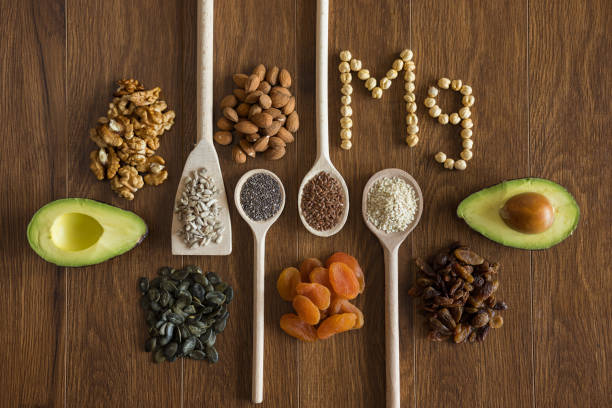Dr Geoff Mullan
We've recently had World Sleep Day and there’s no better time to shine a spotlight on magnesium, one of the most important minerals for good health.
You can read our article on how to improve your sleep here.
In this article:
- What is magnesium and why is it important?
- What foods are high in magnesium?
- What are the chances you are deficient in magnesium?
- Why you might still be deficient even if your blood test was normal...
- Factors affecting magnesium levels
- 4 common types of magnesium supplements
- Reference section
What is magnesium and why is it important?
Very simply, magnesium is a chemical element and mineral. Every cell and every organ needs it, so it is crucial for the body’s healthy functioning.
Your muscles, including your heart, all require magnesium to function. Magnesium is also essential for energy production. So if you suffer from low energy or muscle aches after exercise you may benefit from increasing your magnesium levels.
Magnesium is necessary for the functioning of over 300 different enzymes and 90% of it is found both in bones and in muscles. If you exercise regularly or are an athlete, the chances of being deficient are even higher.
Low levels of magnesium are linked to insomnia and poor sleep, and good sleep is, of course, one of the main pillars of good health.
- Making energy in the mitochondria (ATP production)
- Phase 2 detoxification in the liver
- Making protein, DNA and RNA
- Normal heart rhythm and heart health
- Brain health and reducing the risk of depression (1)
What foods are high in magnesium?
We always recommend a “food first” approach, which means doing our best to get the nutrients we need from food before reaching for supplements. The following foods are good sources of magnesium:
- Nuts like almonds and cashews are great for many different minerals
- Vegetables such as spinach, kale and avocado
- Whole grains: oatmeal and whole wheat
- Dark chocolate
What are the chances you are deficient in magnesium?
After sodium, potassium, and calcium, magnesium is the fourth most common cation in the body, but has the highest levels of deficiency in the developed world. Magnesium deficiency is estimated to occur in 15-20% of the population in the developed world. humanpeople’s testing has found deficiency in 34% of adults, which correlates with a large study done in Mexico that found low magnesium in 36.3% of adults. This is more common than B12 (11%) deficiency
What is deficiency?
There are two types of nutrient deficiency:
-
Frank nutrient deficiency. Think vitamin C deficiency and scurvy, or vitamin D deficiency and rickets (bendy bones). This happens when levels of nutrients are so low that the body cannot compensate and significant diseases occur. Frank magnesium deficiency can cause (2):
- Irregular heart rate
- Brittle bones, osteoperosis, and osteopenia
-
Subclinical deficiency. This is more subtle and more difficult to diagnose. Subclinical vitamin C deficiency will cause poor skin, and reduce the efficiency of the immune system. Low vitamin D is linked to low energy levels and poor immune function. You won’t be healthy, but it is less obvious what is wrong. Subclinical magnesium deficiency (3) can cause:
- Cardiovascular disease (4)
- Poor sleep
- Brain fog and low energy
- Muscle aches
- Poor exercise recovery
- High blood pressure. Low magnesium affects the ability of blood vessels to relax. Diuretics used to treat blood pressure depletes magnesium further and makes things worse.
Why you might still be deficient even if your blood test was normal...
The difficulty in measuring true magnesium levels and why deficiency is under-diagnosed by Doctors
Magnesium is very difficult to measure. 99% of magnesium is found within the cells, so the only true measurement is by taking a muscle biopsy. The easiest and most common way to measure magnesium is looking at a serum (blood) level, but measuring red cell magnesium is more accurate.
There is also a functional medicine test, known as Thoren’s retention test, which can show true deficiency. The test involves giving magnesium and then measuring levels in urine. Using this method it was reckoned that almost 50% of the elderly population are deficient compared to 27.5% of the 18-66 year old population (5).
Why does high mean low?
As I mentioned above, it is possible to do a special magnesium test on red blood cells to give an accurate idea of true body levels. When levels are low in the red blood cells it correlates with a high level in the blood serum. So if you are using the most common method of measuring magnesium levels by analysing the blood serum, a high level in the serum does in fact mean a low level in the red blood cells. This may reflect the body trying to increase the transport and absorption of magnesium by circulating an above average level of magnesium.
This may explain why deficiency is often not diagnosed by doctors (3).
Dietary factors affecting magnesium levels
Magnesium intakes have gradually fallen since the 1940’s because there is less magnesium nowadays in many of our staple foods. This is largely due to the increased refining and processing of food. Magnesium levels in food since the 40's:White flour- Starch ?97%
- Polished rice ?83%
- Parmesan cheese ?70%
- Whole milk ?21%
- Vegetables ?24%
Other factors that cause low magnesium levels
There are a number of factors which can cause low magnesium levels:
- High alcohol consumption
- Age (7). As we get older we have lower acid in the stomach, which this reduces magnesium absorption
- Supplementing with calcium can lead to low magnesium as they compete for absorption in a similar way.
- Heavy menstruation
- High vitamin D can lead to low magnesium levels so it is important to balance this with magnesium and K2 to avoid calcification of arteries.
- Patients with diabetes (4) have low levels of magnesium and low magnesium seems to increase the risk of diabetes.
- Vitamin B6 deficiency can cause magnesium deficiency (8)
- The wrong magnesium supplements! Magnesium oxide and to a lesser extent magnesium citrate are poorly absorbed and cause diarrhoea. Diarrhoea leads to a loss of electrolytes.
4 common types of magnesium supplements
Look for chelated magnesium as this is absorbed more readily with less side effects.1. Magnesium glycinate: best for calming the brain, anxiety, mood, and sleep
This combines elemental magnesium with glycine. Glycine is needed for protein production. Glycine is used to improve sleep as well for heart disease and diabetes. A number of studies (9) have shown that it helps with anxiety, stress and insomnia.
This is humanpeople’s preferred magnesium supplement due to it's high absorption, calming effect and lower propensity to cause diarrhoea.
2. Magnesium threonate: good for brain, mood, and energy
Threonic acid is derived from the breakdown of vitamin C and is combined with magnesium. There is some evidence that it may cross into the brain more easily and help with mood and brain disorders, increasing mental energy. That said, the current evidence is weak and more studies are needed.
This is also a very good magnesium supplement with minimal side effects.
3. Magnesium citrate: good for increasing magnesium levels, but caution- it can act as a laxative
This is bound with citric acid, is easily absorbed and is good for increasing magnesium levels. However, it does have a laxative effect that can be counterproductive. It is safe and relatively inexpensive. Indication: to increase magnesium and treat constipation.
Magnesium citrate is well absorbed but it can act as a laxative so you may need to increase the dose slowly.
4. Magnesium oxide: NOT useful for low magnesium
It is often used to treat heartburn, constipation and indigestion, but NOT for low magnesium. In fact, due to its laxative properties it may make magnesium deficiency worse.
Magnesium oxide is a cheap magnesium that is sometimes given for low magnesium but it will not help. If you are low in magnesium avoid.
Summary
We’ve established that magnesium is critical for the body to function properly and that a deficiency in magnesium can cause a wide range of health problems ranging from low energy and poor sleep to cardiovascular disease. Be sure to do what you can to keep your magnesium levels optimised by eating plenty of magnesium-rich foods such as nuts, leafy greens, whole grains, and dark chocolate.
If you are worried that your levels are low, then the best way to find out is to take a blood test. If you do decide that you need to take a magnesium supplement then we would recommend magnesium glycinate. As always, if you need further advice then we recommend talking to a doctor or nutritionist.
References
1) New paradigms for treatment-resistant depression Ann NY Acad Sci
2) Magnesium Metabolism and its Disorders Clin Biochem Rev 2003
3) The multifaceted and widespread pathology of magnesium deficiency
6) Magnesium status in healthy free-living elderly Norwegians J AM Coll Nutr
7) Effects of aging, chronic disease, and multiple supplements on magnesium requirements
9) Multifarious Beneficial Effect of Nonessential Amino Acid, Glycine: A Review Oxid Med Cell 2017






